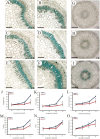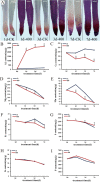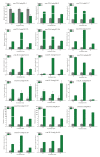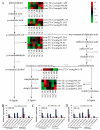Physiological, Biochemical, and Transcriptomic Responses of Neolamarckia cadamba to Aluminum Stress
- PMID: 33348765
- PMCID: PMC7767006
- DOI: 10.3390/ijms21249624
Physiological, Biochemical, and Transcriptomic Responses of Neolamarckia cadamba to Aluminum Stress
Abstract
Aluminum is the most abundant metal of the Earth's crust accounting for 7% of its mass, and release of toxic Al3+ in acid soils restricts plant growth. Neolamarckia cadamba, a fast-growing tree, only grows in tropical regions with acidic soils. In this study, N. cadamba was treated with high concentrations of aluminum under acidic condition (pH 4.5) to study its physiological, biochemical, and molecular response mechanisms against high aluminum stress. High aluminum concentration resulted in significant inhibition of root growth with time in N. cadamba. The concentration of Al3+ ions in the root tip increased significantly and the distribution of absorbed Al3+ was observed in the root tip after Al stress. Meanwhile, the concentration of Ca, Mg, Mn, and Fe was significantly decreased, but P concentration increased. Aluminum stress increased activities of antioxidant enzymes such as superoxide dismutase (SOD), catalase from micrococcus lysodeiktic (CAT), and peroxidase (POD) in the root tip, while the content of MDA was decreased. Transcriptome analysis showed 37,478 differential expression genes (DEGs) and 4096 GOs terms significantly associated with treatments. The expression of genes regulating aluminum transport and abscisic acid synthesis was significantly upregulated; however, the genes involved in auxin synthesis were downregulated. Of note, the transcripts of several key enzymes affecting lignin monomer synthesis in phenylalanine pathway were upregulated. Our results shed light on the physiological and molecular mechanisms of aluminum stress tolerance in N. cadamba.
Keywords: DEGs; Neolamarckia cadamba; ROS; aluminum stress; hormone; signal transduction.
Conflict of interest statement
The authors declare no conflict of interest.
Figures












Similar articles
-
Transcriptomic Analysis of Multipurpose Timber Yielding Tree Neolamarckia cadamba during Xylogenesis Using RNA-Seq.PLoS One. 2016 Jul 20;11(7):e0159407. doi: 10.1371/journal.pone.0159407. eCollection 2016. PLoS One. 2016. PMID: 27438485 Free PMC article.
-
Transcriptomic and metabolomic approaches reveal the physiological and biochemical alleviation mechanisms of silicon on aluminum stress in Juglans sigillata.Plant Physiol Biochem. 2025 Apr;221:109604. doi: 10.1016/j.plaphy.2025.109604. Epub 2025 Feb 6. Plant Physiol Biochem. 2025. PMID: 39938159
-
Physiological and comprehensive transcriptome analysis reveals distinct regulatory mechanisms for aluminum tolerance of Trifolium repens.Ecotoxicol Environ Saf. 2024 Oct 1;284:117001. doi: 10.1016/j.ecoenv.2024.117001. Epub 2024 Sep 4. Ecotoxicol Environ Saf. 2024. PMID: 39236654
-
Traditional uses, phytochemistry and pharmacological properties of Neolamarckia cadamba: A review.J Ethnopharmacol. 2016 Apr 2;181:118-35. doi: 10.1016/j.jep.2016.01.036. Epub 2016 Jan 25. J Ethnopharmacol. 2016. PMID: 26821190 Review.
-
Alleviating aluminum toxicity in plants: Implications of reactive oxygen species signaling and crosstalk with other signaling pathways.Physiol Plant. 2021 Dec;173(4):1765-1784. doi: 10.1111/ppl.13382. Epub 2021 Mar 17. Physiol Plant. 2021. PMID: 33665830 Review.
Cited by
-
Nitric Oxide Participates in Aluminum-Stress-Induced Pollen Tube Growth Inhibition in Tea (Camelliasinensis) by Regulating CsALMTs.Plants (Basel). 2022 Aug 29;11(17):2233. doi: 10.3390/plants11172233. Plants (Basel). 2022. PMID: 36079615 Free PMC article.
-
Genome mining of metabolic gene clusters in the Rubiaceae family.Comput Struct Biotechnol J. 2023 Nov 20;23:22-33. doi: 10.1016/j.csbj.2023.11.034. eCollection 2024 Dec. Comput Struct Biotechnol J. 2023. PMID: 38075396 Free PMC article.
-
Transcriptome Analysis Revealed the Mechanisms Involved in Ultrasonic Seed Treatment-Induced Aluminum Tolerance in Peanut.Front Plant Sci. 2022 Feb 8;12:807021. doi: 10.3389/fpls.2021.807021. eCollection 2021. Front Plant Sci. 2022. PMID: 35211134 Free PMC article.
-
OsAlR3 regulates aluminum tolerance through promoting the secretion of organic acids and the expression of antioxidant genes in rice.BMC Plant Biol. 2024 Jun 28;24(1):618. doi: 10.1186/s12870-024-05298-9. BMC Plant Biol. 2024. PMID: 38937693 Free PMC article.
-
The Physiological Response Mechanism of Peanut Leaves under Al Stress.Plants (Basel). 2024 Jun 10;13(12):1606. doi: 10.3390/plants13121606. Plants (Basel). 2024. PMID: 38931038 Free PMC article.
References
-
- Hoekenga O.A., Vision T.J., Shaff J.E., Monforte A.J., Lee G.P., Howell S.H., Kochian L.V. Identification and characterization of aluminum tolerance loci in Arabidopsis (Landsberg erecta x Columbia) by quantitative trait locus mapping. A physiologically simple but genetically complex trait. Plant Physiol. 2003;132:936–948. doi: 10.1104/pp.103.023085. - DOI - PMC - PubMed
-
- Samac D.A., Tesfaye M. Plant improvement for tolerance to aluminum in acid soils—A review. Plant Cell Tissue Organ Cult. (PCTOC) 2003;75:189–207. doi: 10.1023/A:1025843829545. - DOI
MeSH terms
Substances
LinkOut - more resources
Full Text Sources
Miscellaneous

